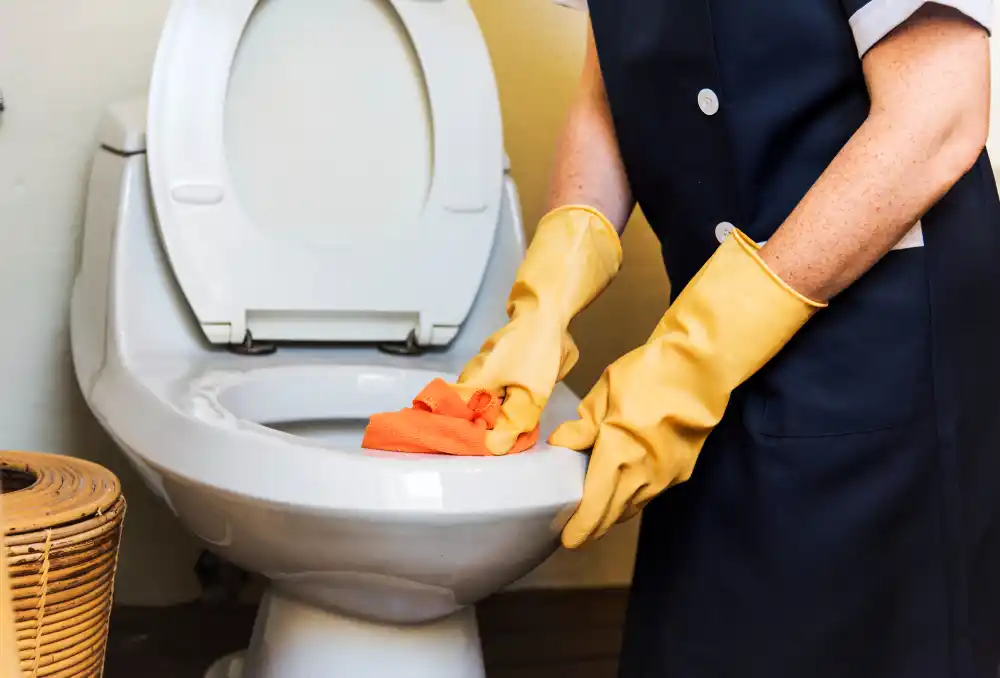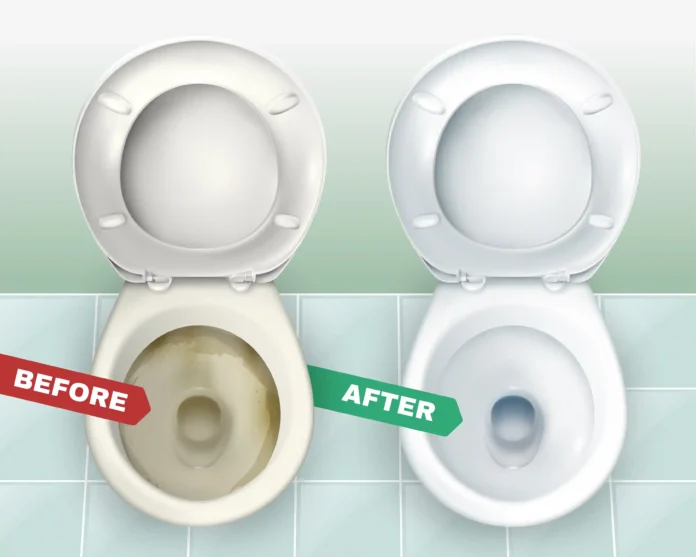Dealing with limescale in toilets, especially under the waterline, is a common headache for homeowners. It’s not just about the unpleasant look – limescale can really impact how well your toilet works. This guide is here to help. We’ll show you how to tackle limescale, not only getting rid of it but also keeping it from coming back. With these tips, you can keep your toilet sparkling clean and working smoothly.
What is Limescale?
Ever noticed a rough, white or yellowish crust in your toilet bowl? That’s limescale. It’s mostly made of calcium carbonate, a stuff left behind when hard water dries up. Limescale loves to hang out below the waterline in your toilet, clinging on and forming tough stains that can be a pain to clean.
Why Remove Limescale?
You might think limescale is just a cosmetic issue, but it’s more than that. When limescale builds up, it can mess with your toilet’s flow and flush. This can mean more water used every time you flush and, over time, could even lead to blocked pipes. Getting rid of limescale not only keeps your toilet looking neat but also helps it work better and saves water.
How to Remove Limescale from Toilet – Step-by-Step Guide
1. Turn Off the Water and Empty the Bowl
First, you need to stop water from coming into the toilet. Find the valve behind the toilet and turn it off. Then flush your toilet. This will lower the water and let you see all the limescale that’s hiding below.
2. Pick Your Cleaner
You can use special limescale removers from the store, or go natural with white vinegar or lemon juice. These are great at breaking down limescale.
3. Apply the Cleaner to the Limescale
Pour your chosen cleaner right onto the limescale. If it’s really tough, soak some toilet paper in the cleaner and stick it to the stained areas. Let it sit for a few hours, or even overnight if you can.
4. Time to Scrub
After the cleaner has done its job, grab a toilet brush or a pumice stone. Gently scrub at the limescale. If you’re using a pumice stone, be gentle to avoid scratches.
5. Flush and Check
Turn the water back on and flush the toilet a few times. This will rinse away the cleaner and any limescale you’ve scrubbed off. Take a look and see if you got it all. If not, you can repeat the process.
And there you go – a limescale-free toilet!

You may also like to Read: How to Manually Flush a Toilet with DIY Guide
Best Practices for Removing Limescale from Toilet Below the Waterline
Getting rid of limescale below the waterline in your toilet might seem tough, but with the right approach, it can be easier than you think. Here’s what you can do:
1. Longer Soaking Time
Limescale below the waterline can be pretty stubborn. So, it’s a good idea to let your cleaning solution sit there for a longer time. This could mean a few hours or even overnight. The longer it soaks, the easier it will be to scrub off.
2. Use the Right Tools
For those hard-to-reach areas below the waterline, a good toilet brush or a pumice stone can work wonders. Just remember, if you’re using a pumice stone, scrub gently to avoid scratches on the toilet bowl.
3,. Regular Cleaning is Key
The best way to deal with limescale is not to let it build up in the first place. Try to clean your toilet regularly, at least once a week. This stops limescale from getting too tough and makes it easier to clean.
4. Try Different Cleaners
Sometimes, one cleaner might not do the trick. Don’t be afraid to try different types, like commercial limescale removers, vinegar, or even cola. Different cleaners can work better on different types of stains.
5. Stay Safe
When you’re dealing with cleaners, especially chemical ones, make sure your bathroom is well-ventilated. And always wear gloves to protect your hands.
By following these simple tips, you can keep the limescale below the waterline under control and your toilet looking and working great.
You might interested to Read: Why does my Bathroom Smell Like Sewage
Preventing Limescale in Toilets
Stopping limescale from building in your toilet in the first place is a lot easier than trying to remove it later. Here are some easy tips to help you stop limescale before it starts:
- Regular Cleaning
One of the best ways to prevent limescale is to clean your toilet regularly. You don’t need anything fancy – just your usual toilet cleaner and a brush. Give it a good scrub once a week to stop limescale from settling in.
- Use a Water Softener
If you live in an area with hard water, consider getting a water softener. This device reduces the minerals in your water that cause limescale. It’s not just good for your toilet but can help with limescale in other parts of your home too.
- Try Natural Cleaners
Natural cleaners like vinegar can help keep limescale away. Just pour a bit of vinegar into the toilet bowl every now and then, let it sit for a while, and then flush. It’s a simple, eco-friendly way to fight limescale.
- Check for Leaks
Sometimes, a leaking toilet can lead to more limescale. Make sure everything is working right and fix any leaks as soon as you spot them.
- Toilet Freshening Blocks
You can use those blue blocks that hang in your toilet bowl or drop-in tank tablets. They help keep the toilet clean and smelling fresh, which can also help in preventing limescale.
By following these straightforward tips, you can greatly reduce the chances of limescale forming in your toilet, saving you time and effort in the long run.

Conclusion
Removing limescale from the toilet below the waterline requires patience and the right approach. By understanding what limescale is, how it forms, and how to effectively remove it, you can keep your toilet in top condition. Regular cleaning and preventive measures can also go a long way in making this task less daunting over time.
You may also interested in: How to Unclog a Bathroom Sink
FAQs
What is the most effective way to remove limescale from below the toilet waterline?
The most effective method is to use a strong acidic cleaner like white vinegar or a commercial limescale remover. Apply it directly to the limescale, let it soak for several hours, and then scrub with a toilet brush or pumice stone.
Can household items be used to remove limescale from toilets?
Yes, household items like white vinegar, lemon juice, or cola can be effective in removing limescale. These acidic solutions help break down the limescale for easier removal.
How to Remove Limescale from Toilet Rim?
Removing limescale from the toilet rim is quite straightforward. Start by applying a limescale removal solution – this can be a commercial cleaner or a home remedy like white vinegar or lemon juice. Apply the cleaner directly under the rim and let it sit for a few hours to break down the limescale. For tougher build-up, you can use a toilet brush or an old toothbrush to scrub gently under the rim. After scrubbing, flush the toilet to rinse away the cleaner and limescale. Regular cleaning can prevent future limescale build-up in this area.
How often should I clean my toilet to prevent limescale buildup?
Regular cleaning, ideally once a week, is key to preventing limescale buildup. Consistent cleaning prevents limescale from becoming too hard and difficult to remove.
Is it safe to use vinegar to remove limescale in a toilet with a septic system?
Yes, vinegar is safe to use in toilets with septic systems. It’s a natural, eco-friendly cleaner that won’t harm the beneficial bacteria in your septic tank.
Can limescale in toilets cause damage or affect toilet functionality?
Yes, limescale buildup can lead to reduced efficiency in flushing and can cause blockages, which might lead to higher water usage and potential plumbing problems.







